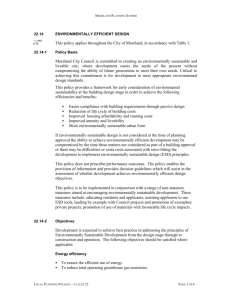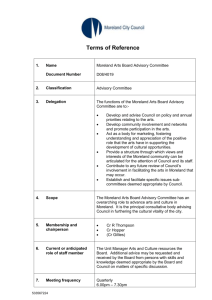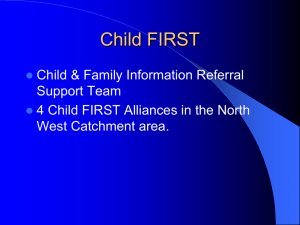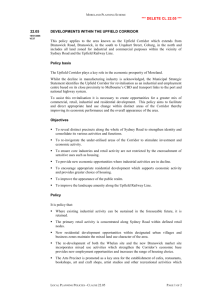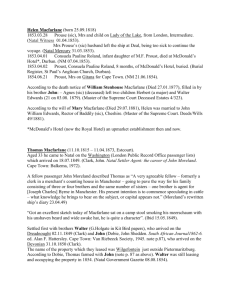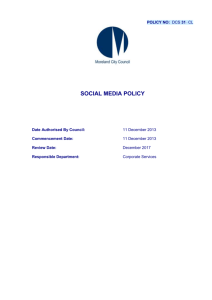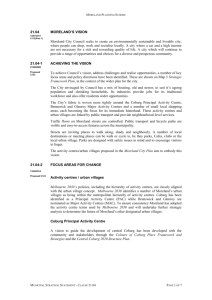MINISTERIAL DIRECTION - Moreland City Council
advertisement
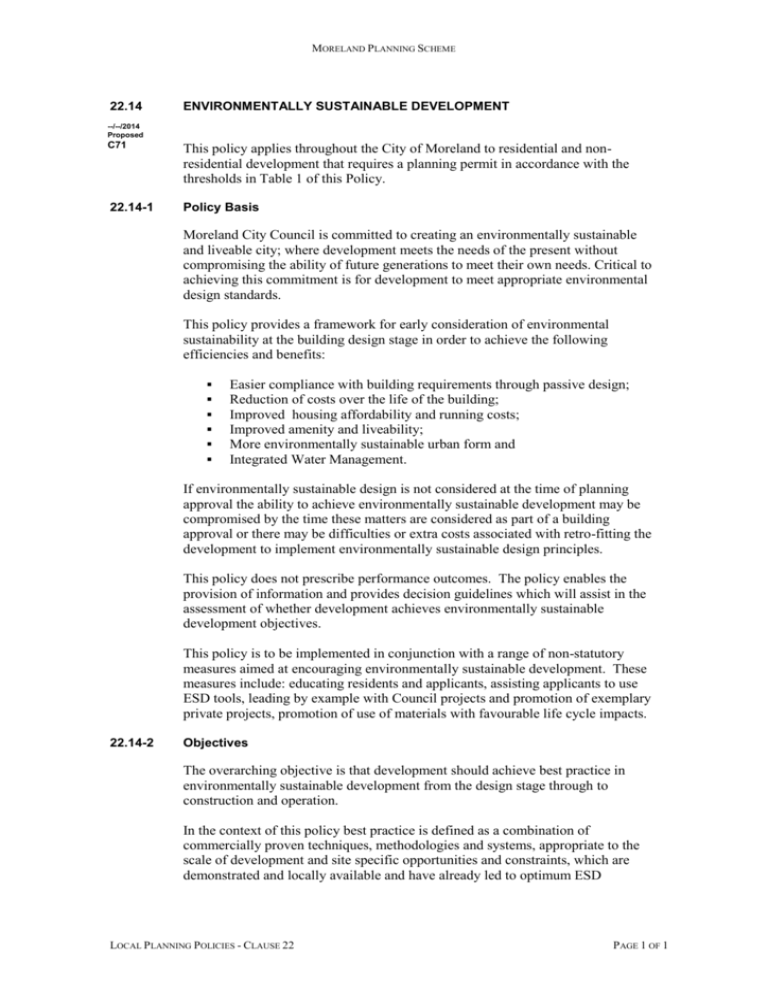
MORELAND PLANNING SCHEME 22.14 ENVIRONMENTALLY SUSTAINABLE DEVELOPMENT --/--/2014 Proposed C71 This policy applies throughout the City of Moreland to residential and nonresidential development that requires a planning permit in accordance with the thresholds in Table 1 of this Policy. 22.14-1 Policy Basis Moreland City Council is committed to creating an environmentally sustainable and liveable city; where development meets the needs of the present without compromising the ability of future generations to meet their own needs. Critical to achieving this commitment is for development to meet appropriate environmental design standards. This policy provides a framework for early consideration of environmental sustainability at the building design stage in order to achieve the following efficiencies and benefits: Easier compliance with building requirements through passive design; Reduction of costs over the life of the building; Improved housing affordability and running costs; Improved amenity and liveability; More environmentally sustainable urban form and Integrated Water Management. If environmentally sustainable design is not considered at the time of planning approval the ability to achieve environmentally sustainable development may be compromised by the time these matters are considered as part of a building approval or there may be difficulties or extra costs associated with retro-fitting the development to implement environmentally sustainable design principles. This policy does not prescribe performance outcomes. The policy enables the provision of information and provides decision guidelines which will assist in the assessment of whether development achieves environmentally sustainable development objectives. This policy is to be implemented in conjunction with a range of non-statutory measures aimed at encouraging environmentally sustainable development. These measures include: educating residents and applicants, assisting applicants to use ESD tools, leading by example with Council projects and promotion of exemplary private projects, promotion of use of materials with favourable life cycle impacts. 22.14-2 Objectives The overarching objective is that development should achieve best practice in environmentally sustainable development from the design stage through to construction and operation. In the context of this policy best practice is defined as a combination of commercially proven techniques, methodologies and systems, appropriate to the scale of development and site specific opportunities and constraints, which are demonstrated and locally available and have already led to optimum ESD LOCAL P LANNING POLICIES - CLAUSE 22 PAGE 1 OF 1 MORELAND PLANNING SCHEME outcomes. Best practice in the built environment encompasses the full life of the build. It is a policy objective to encourage innovative technology, design and processes in all development, which positively influence the sustainability of buildings. The following objectives should be satisfied where applicable: Energy efficiency To ensure the efficient use of energy. To reduce total operating greenhouse gas emissions. To reduce energy peak demand. Water resources To ensure the efficient use of water. To reduce total operating potable water use. To encourage the collection and reuse of stormwater. To encourage the appropriate use of alternative water sources (eg. greywater). Indoor Environment Quality To achieve a healthy indoor environment quality for the wellbeing of building occupants, including the provision of fresh air intake, cross ventilation, natural daylight, and appropriate levels of lighting. To achieve thermal comfort levels with minimised need for mechanical heating, ventilation and cooling. To reduce indoor air pollutants by use of materials with low toxic chemicals, minimal off-gassing and production of allergens. To reduce reliance on mechanical heating, ventilation, cooling and lighting systems. To use flexible internal controls for any mechanical systems. To minimise noise levels and noise transfer within and between buildings and associated external areas. Stormwater Management To reduce the impact of stormwater run-off. To improve the water quality of stormwater run-off. To achieve best practice stormwater quality outcomes. To incorporate the use of water sensitive urban design, including stormwater re-use. Transport To ensure that the built environment is designed to promote the use of walking, cycling and public transport in that order. To minimise car dependency. To promote the use of low emissions vehicle technologies and supporting infrastructure. Waste management LOCAL P LANNING POLICIES - CLAUSE 22 PAGE 2 OF 1 MORELAND PLANNING SCHEME To ensure waste avoidance, reuse and recycling during the design, construction and operation stages of development. To ensure durability and long term reusability of building materials. To ensure the built environment can adapt to future needs in a waste-efficient manner. Urban Ecology 22.14-3 To protect and enhance biodiversity within the municipality. To provide environmentally sustainable landscapes and natural habitats, and minimise the urban heat island effect. To protect and manage all remnant indigenous plant communities. To encourage the planting of indigenous vegetation. To encourage productive gardens. Policy It is policy that applications for the types of development listed in Table 1 be accompanied by a Sustainable Design Assessment or Sustainability Management Plan which: utilises relevant assessment tools; and addresses relevant policy objectives. It is policy that applications for larger non-residential developments (as specified in Table 1) be accompanied by a Green Travel Plan. The application requirements set out in 22.14-4 do not apply to alterations or extensions to existing non-residential developments over 20,000sqm gross floor area in respect of which an ESD plan or framework: has been approved by the Responsible Authority (whether under a planning control or otherwise); sets out environmental targets or performance standards for that development that have the capacity to satisfy the objectives of this policy; and set out specific ESD assessment requirements for future permit applications in respect of that development. 22.14-4 Application Requirements An application must be accompanied by either a Sustainable Design Assessment or a Sustainability Management Plan as specified in Table 1, as appropriate. A Sustainable Design Assessment will usually not need to be prepared by a suitably qualified professional. It should: provide a simple assessment of the development using relevant tools from the example tools listed in the table (or equivalent tools); identify environmentally sustainable development measures proposed in response to policy objectives. A Sustainability Management Plan should: provide a detailed assessment of the development using relevant tools from the example tools listed in the table (or equivalent tools); LOCAL P LANNING POLICIES - CLAUSE 22 PAGE 3 OF 1 MORELAND PLANNING SCHEME identify appropriate environmental targets or performance standards having regard to the objectives of this policy (as appropriate); demonstrate that the building has the design potential to achieve the relevant environmental targets or performance standards; document the means by which the targets or performance standards will be achieved. Various ‘tools’ have been listed in Table 1 which may be used to assess how the proposed development addresses the objectives of this policy, as appropriate. It is not intended that this is an exhaustive list and applicants may use other tools or methods to the satisfaction of the Responsible Authority. Council has also developed a range of documents) to guide applicants such as the Moreland Sustainable Design Assessment in the Planning Process (SDAPP) Fact Sheets. Table 1 – ESD Application Requirements TYPE OF DEVELOPMENT APPLICATION REQUIREMENTS EXAMPLE TOOLS Sustainable Design Assessment (SDA) STEPS Accommodation/Mixed Use with residential component of: 2- 9 dwellings; or Development of a building for accommodation with a gross floor area between 50m2 and 1000m2. Development of 10 or more dwellings. Development of a building for accommodation other than dwelling with a gross floor area of more than 1000m2. Non-residential Development of a non- residential building with a gross floor area between 100m² and 1000m²; or Alterations and additions of between 100m² and 1000m². Development of a non- residential building with a gross floor area of LOCAL P LANNING POLICIES - CLAUSE 22 STORM Sustainability Management Plan (SMP) STEPS Green Star MUSIC STORM Sustainable Design Assessment (SDA) SDS MUSIC STORM Sustainability Management Plan (SMP) Green Star SDS PAGE 4 OF 1 MORELAND PLANNING SCHEME more than 1000m²; Green Travel Plan (GTP) Alterations and additions MUSIC greater than 1000m². STORM Note 1: Mixed Use developments are required to provide the information applicable to each use component of the development and apply the relevant tools for each, as identified in Table 1. Note 2: In the case of alterations and additions, the requirements of the Policy apply only to the alterations and additions. Note 3: Applications for development types that cannot be assessed by a rating tool can be assessed by an alternative form of assessment to the satisfaction of the Responsible Authority. 22.14-5 Decision Guidelines In determining an application, the Responsible Authority will consider as appropriate: 22.14-6 The extent to which the development meets the objectives and requirements of this policy from the design stage through to construction and operation. Site constraints and opportunities. Whether the proposed environmentally sustainable development initiatives are functional and effective to prevent or minimise environmental impact. Whether the proposed environmentally sustainable development initiatives are reasonable having regard to the type and scale of the development. Whether appropriate tools or alternative assessment methods have been used. In circumstances requiring a Sustainable Design Assessment, whether the development has been designed to be able to meet any minimum environmental targets set within relevant tools. In circumstances requiring a Sustainability Management Plan: - whether appropriate environmental targets have been set; and - whether the development has been designed to be able to meet the environmental targets. Reference Documents Nationwide House Energy Rating Scheme (NatHERS), Department of Climate Change and Energy Efficiency, www.nathers.gov.au Green Star, Green Building Council of Australia www.gbca.com.au Guide for Best Practise for Waste Management in Multi-Unit Developments, Sustainability Victoria, 2010 LOCAL P LANNING POLICIES - CLAUSE 22 PAGE 5 OF 1 MORELAND PLANNING SCHEME Moreland Greenlist (prepared by Moreland City Council and based on information adapted from VicUrban’s ‘Eco Selector’ in conjunction with RMIT’s Centre for Design) STEPS (Sustainable Tools for Environmental Performance Strategy), Moreland City Council, www.sustainablesteps.com.au Moreland Stormwater Quality Targets, Moreland City Council, 2012. Moreland Sustainable Design Assessment in the Planning Process (SDAPP) Key Sustainable Building Categories Fact Sheets: 1. Indoor Encvironment Quality 2. Energy Efficiency 3. Water Efficiency 4. Stormwater Management 5. Building Materials 6. Transport 7. Waste Management 8. Urban Ecology 9. Innovation 10. Construction & Building Management www.moreland.vic.gov.au STORM, Melbourne Water, www.storm.melbournewater.com.au Sustainable Design Scorecard (SDS) Non-Residential environmental assessment tool, Moreland City Council and City of Port Phillip, www.portphillip.vic.gov.au/sds, 1999. Urban Stormwater Best Practice Guidelines, CSIRO, 2006. Your Home Technical Manual, Department of the Environment, Water, Heritage and the Arts, www.yourhome.gov.au, 2001 Note: The above reference documents and websites may be amended from time to time. It is intended that these documents and websites (or amended versions) are relevant reference documents to this policy. 22.14-7 Commencement The ESD Application Requirements in Table 1 for a Sustainable Design Assessment (SDA) will commence on the 1 July 2015. 22.14-8 Expiry This policy will expire if it is superseded by an equivalent provision of the Victoria Planning Provisions. LOCAL P LANNING POLICIES - CLAUSE 22 PAGE 6 OF 1

